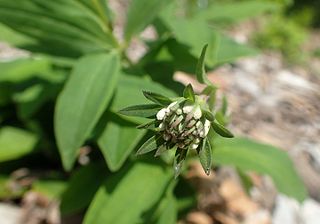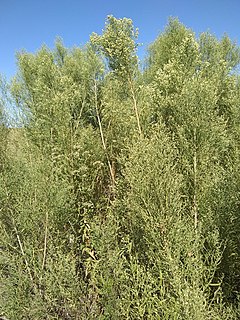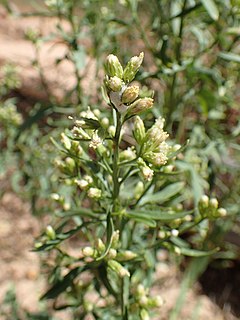
Asimina is a genus of small trees or shrubs described as a genus in 1763. Asimina is the only temperate genus in the tropical and subtropical flowering plant family, Annonaceae.

Elaeagnus angustifolia, commonly called Russian olive, silver berry, oleaster, or wild olive, is a species of Elaeagnus, native to western and central Asia, Iran, from southern Russia and Kazakhstan to Turkey, parts of Pakistan and parts of India. As of 2020, it is widely established in North America as an introduced species.

Panicum (panicgrass) is a large genus of about 450 species of grasses native throughout the tropical regions of the world, with a few species extending into the northern temperate zone. They are often large, annual or perennial grasses, growing to 1–3 m tall.

Baccharis is a genus of perennials and shrubs in the aster family (Asteraceae). They are commonly known as baccharises but sometimes referred to as "brooms", because many members have small thin leaves resembling the true brooms. They are not at all related to these however, but belong to an entirely different lineage of eudicots. B. halimifolia is commonly known as "groundsel bush", however true groundsels are found in the genus Senecio.

Lavandula angustifolia, formerly L. officinalis, is a flowering plant in the family Lamiaceae, native to the Mediterranean. Its common names include lavender, true lavender or English lavender ; also garden lavender, common lavender, and narrow-leaved lavender.

Marshallia is a genus of plants in the tribe Helenieae within the family Asteraceae. Marshallia is native to the southeastern and south-central United States. A common name applied to most species in the genus is Barbara's buttons.

Baccharis halimifolia is a North American species of shrubs in the family Asteraceae. It is native to Nova Scotia, the eastern and southern United States, eastern Mexico, the Bahamas, and Cuba.

Artemisia campestris is a common and widespread species of plants in the sunflower family, Asteraceae. It is native to a wide region of Eurasia and North America. Common names include field wormwood, beach wormwood, northern wormwood, Breckland wormwood, boreal wormwood, Canadian wormwood, field sagewort and field mugwort.

Malus angustifolia, or southern crabapple, is a species of crabapple native to the eastern and south-central United States from Florida west to eastern Texas and north to New Jersey, Pennsylvania, Illinois and Missouri.

Baccharis brachyphylla is a North American species of shrub in the family Asteraceae, known by the common name shortleaf baccharis or false willow. It is native to the southwestern United States and northern Mexico. It grows in desert habitats such as arroyos and canyons.

Baccharis sergiloides is a species of Baccharis known by the common name desert baccharis.

Baccharis neglecta is a species of perennial plant in the family Asteraceae. It is native to northern Mexico and the south-western and south-central United States.

Baccharis salicina is a species of plant in the family Asteraceae. Common names include willow baccharis, and Great Plains false willow. It is a shrub found in North America where it grows in mildly saline areas.

Salix elaeagnos the bitter willow, olive willow, hoary willow, rosemary willow, or elaeagnus willow, is a species of flowering plant in the family Salicaceae, native to central and southern Europe and south west Asia. Growing to 3 m (10 ft) tall by 5 m (16 ft) broad, it is an erect bushy deciduous shrub with narrow grey-green leaves up to 20 cm (8 in) long, which turn yellow in autumn (fall). The green catkins, 3–6 cm (1–2 in) long, appear with the leaves in spring, male catkins having yellow anthers.
Baccharis bigelovii is a North American species of shrubs in the family Asteraceae known by the common name Bigelow's false willow . It is found in the Chihuahuan Desert and nearby regions of the United States and Mexico, in the States of Chihuahua, Durango, Sonora, Arizona, New Mexico, and Texas.
Baccharis glomeruliflora is a North American species of shrubs in the family Asteraceae known by the common name silverling. It is native to the coastal plain of the southeastern United States, from Mississippi to North Carolina.
Baccharis havardii is a North American species of shrubs in the family Asteraceae known by the common name Havard's false willow. It is native to Chihuahua, southern New Mexico, and western Texas.
Baccharis texana is a North American species of shrubs in the family Asteraceae known by the common name prairie baccharis or false willow. It is native to northeastern Mexico and to the southern part of the Great Plains of the United States.

Baccharis wrightii is a North American species of shrubs in the family Asteraceae known by the common name Wright's baccharis or false willow. It is native to northern Mexico and the southwestern and south-central United States.

Vernonia angustifolia is a species of flowering plant in the family Asteraceae, native to the southeastern United States. It was first described by André Michaux in 1803.
















